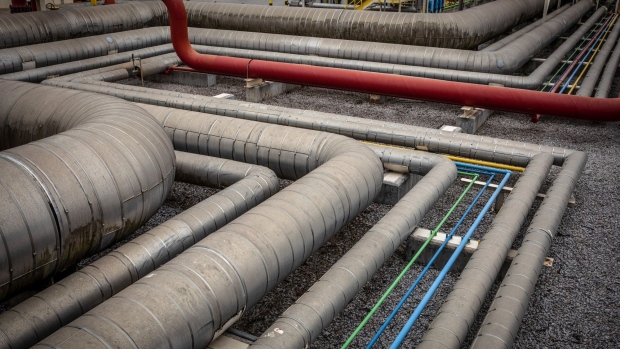Oct 17, 2022
Europe Gas Drops to 3-Month Low as EU Plans More Crisis Measures
, Bloomberg News

(Bloomberg) -- European natural gas fell to the lowest level since June as the EU prepares measures to curb volatility in the region’s biggest marketplace.
Benchmark futures fell 9.9%, also helped lower by mild weather, a steady inflow of liquefied natural gas and high winter stockpiles.
The European Commission is set to unveil a proposal on a temporary dynamic price limit for transactions on the Dutch Title Transfer Facility. It will, however, stop short of putting forward a detailed plan to make it work immediately, and instead seek empowerment from governments to come up with such a mechanism as a last resort, according to a draft of the EU document seen by Bloomberg.
Read more: EU to Offer Last-Resort Plan for Gas-Price Cap on Dutch Hub
The measures will be discussed by European Union leaders at their summit on Oct. 20-21 as they seek to alleviate the impact of Russia’s steep gas supply cuts on companies and consumers. Some relief has come from fuller-than-usual inventories, which have contributed to prices dropping more than 60% from levels in late August.
“Several countries in Europe announced that the supply picture is healthy ahead of the upcoming winter, while mild and windy weather means that demand has not really started to rise yet at this point of time,” Energi Denmark said in a note.
Europe’s gas storage facilities are about 92% full, above the five-year average for the time of the year, helped by favorable weather and high levels of LNG imports. But failure to cut consumption and a colder-than-normal winter could deplete the reservoirs quickly and make it much harder to replenish them next year, particularly without the usual volumes of Russia gas.
Click here to read Bloomberg’s daily Europe Energy Crunch blog
The EU has already asked members to voluntarily reduce gas demand by 15%, and Energy Commissioner Kadri Simson has said a plan is under consideration to make cuts mandatory. She warned over the weekend that measures to limit gas prices must not hinder efforts to curb demand, a view shared by analysts from Morgan Stanley to Citigroup Inc.
Meanwhile, the UK’s program to freeze energy prices to help households shoulder the burden of rising costs will be scrapped at the end of this heating season, as the government seeks to salvage its credibility with investors.
LNG Flows
Dutch front-month gas, the European benchmark, dropped for a third straight session to 127.98 euros per megawatt-hour, the lowest since June 22. The UK equivalent contract fell 11%.
“Gas prices are likely to continue to fall with the arrival of significant amounts of LNG into Europe and as storage facilities get ever closer to full,” analysts at Alfa Energy said in a note.
NW EUROPE LNG TRACKER: US Import Deluge Shows No Sign of Slowing
Still, the escalating war in Ukraine continues to bring the risk of disruption to gas supplies that pass through the country. Central Kyiv was hit by explosions early Monday after Russia used kamikaze drones, according to the Ukraine president’s chief of staff Andriy Yermak. For now, transit flows remain stable, albeit at the reduced levels of the past few months.
Traders are also keeping an eye on demand for LNG in Asia, which could present Europe with stiff competition for cargoes during the colder months. China told its state-owned importers to stop reselling LNG in order to ensure its own supply for the winter.
©2022 Bloomberg L.P.





